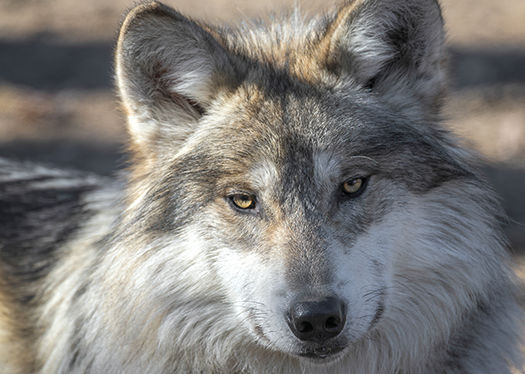
The Mexican gray wolf is North America’s rarest gray wolf subspecies. (Photo by Shutterstock/Nagel Photography)
Conservationists are speaking out against the Jan. 22 capture of a female Mexican gray wolf (Canis lupus baileyi) by the New Mexico Department of Game and Fish near Taos, New Mexico.
The U.S. Fish and Wildlife Service (USFWS) said the radio-collared animal, designated wolf f2754 by the agency but named Asha by wolf advocates, was removed from the wild because it was wandering in an area lacking other known wolves. The agency said that as a result, there was a “high likelihood of a negative interaction or breeding with domestic dogs.”
Capture of the wolf has rekindled debate about whether the endangered animals’ range should be artificially limited to a federally designated Mexican gray wolf species-recovery area that runs across southern and central New Mexico and Arizona between I-40 and the U.S.-Mexican border.
Authorities try to recapture and relocate collared wolves that occasionally stray north of that zone, as the wolf dubbed Asha certainly did. Taos is over 100 miles north of I-40, the northern edge of the zone.
USFWS plans to send the wolf and a male wolf to Mexico to boost the genetic diversity of the Mexican gray wolf population south of the border, a population that is significantly smaller than that of the U.S. recovery zone.
Binational recovery work
Mexico and the United States are partners in a binational program to rebuild populations of the Mexican gray wolf, the rarest subspecies of gray wolf in North America. The subspecies, whose range once stretched from the current-day U.S. southwest as far south as central Mexico, was nearly exterminated by government eradication campaigns on both sides of the border during the 20th century.
The last count found 196 Mexican gray wolves in Arizona and New Mexico at the end of 2021. In Mexico, where wolf reintroduction began in earnest in 2011, some 40-45 of the animals were believed to occupy an area straddling the northern states of Sonora and Chihuahua. (See "Mexican gray wolf reclaims border terrain" —EcoAméricas, November 2021.)
While the numbers represent a rebound for a subspecies that nearly went extinct, experts consider the wolf’s recovery tentative. Citing scientific research, wolf advocates contend that at least 750 animals should roam wild—in the border region and beyond—to ensure a robust Mexican gray wolf population.
Since U.S. reintroduction efforts got underway 25 years ago, they have drawn opposition from ranchers who complain that the wolves threaten their herds despite the efforts of wildlife managers to keep the predators away from livestock.
Wolf conservationists, for their part, have long opposed the artificial boundaries limiting the wolves’ range, whether to the north or south of the recovery zone. They contend such restrictions make it harder for the animals to maintain the genetic diversity needed for population health. And they are currently pressing that point in a consolidated lawsuit in the U.S. District Court in Arizona, notes attorney Aaron Bloom of the San Francisco, California-based environmental-law nonprofit Earthjustice.
Their concern has only deepened amid the many projects in recent years to extend and strengthen walls along the border. Intended to stop migrants from entering the United States, the wall-building has effectively fragmented wildlife habitat in the border region. “How sadly ironic to capture a northward-roaming Mexican gray wolf to return her to Mexico only a year after the border wall blocked another wolf from reaching Mexico,” Michael Robinson, senior conservation advocate at the Tucson, Arizona-based nonprofit Center for Biological Diversity (CBD), said in a press release.
Ranging more widely
It is by no means unheard of for wolves to venture north or south of the recovery zone. In 2021 a male wolf was found to have repeatedly trekked north of I-40 in Arizona. USFWS tracking data shows that the next year, a wolf was documented near Albuquerque, New Mexico, which is traversed by Interstate 40. Conservationists say such events should be an accepted part of wolf-recovery efforts. Three days before the capture of the wolf known as Asha, the CBD and 18 cosigners wrote the USFWS and New Mexico Department of Game and Fish urging that the animal be allowed to roam freely.
Chris Smith of WildEarth Guardians, a wildlife protection and restoration nonprofit headquartered in Santa Fe, New Mexico, characterizes the capture of the wolf near Taos as an example of wildlife managers “taking the wild out of the wolf.” He says the wolf’s trek underscores the possibility that Mexican gray wolves could establish or reestablish a range in the southern Rockies and possibly interconnect with the larger gray wolf (Canis lupus), which shows signs of pushing south along the Rockies.
That possibility could grow stronger following Colorado’s launch this year of a wolf-recovery effort mandated by state voters in 2020, Smith notes. Public comment on a draft management plan is being accepted by Colorado Parks and Wildlife until Feb. 22.
- Kent Paterson
Public comment on Colorado wolf-restoration plan: link